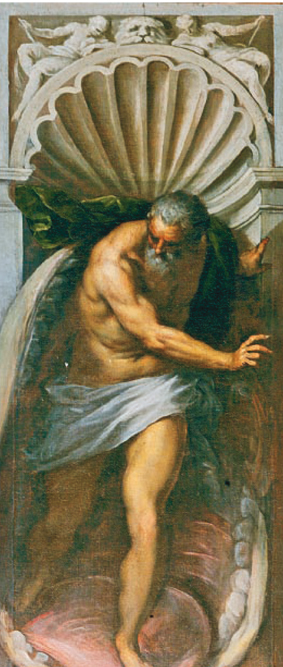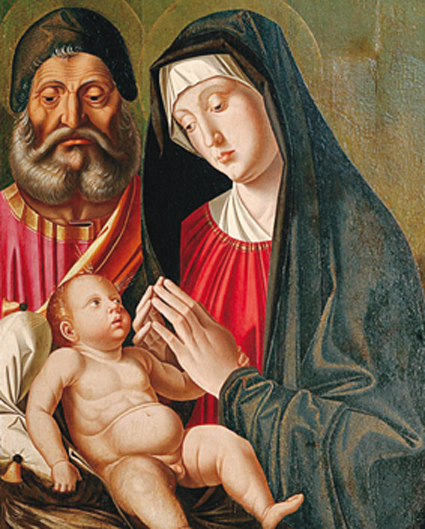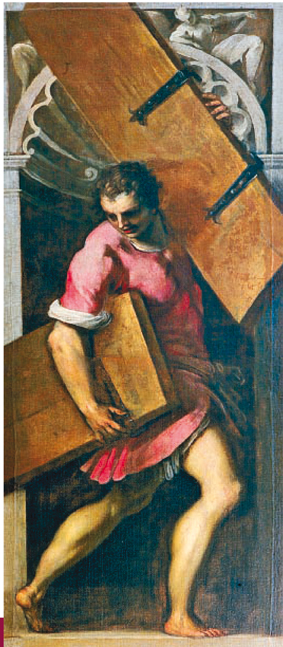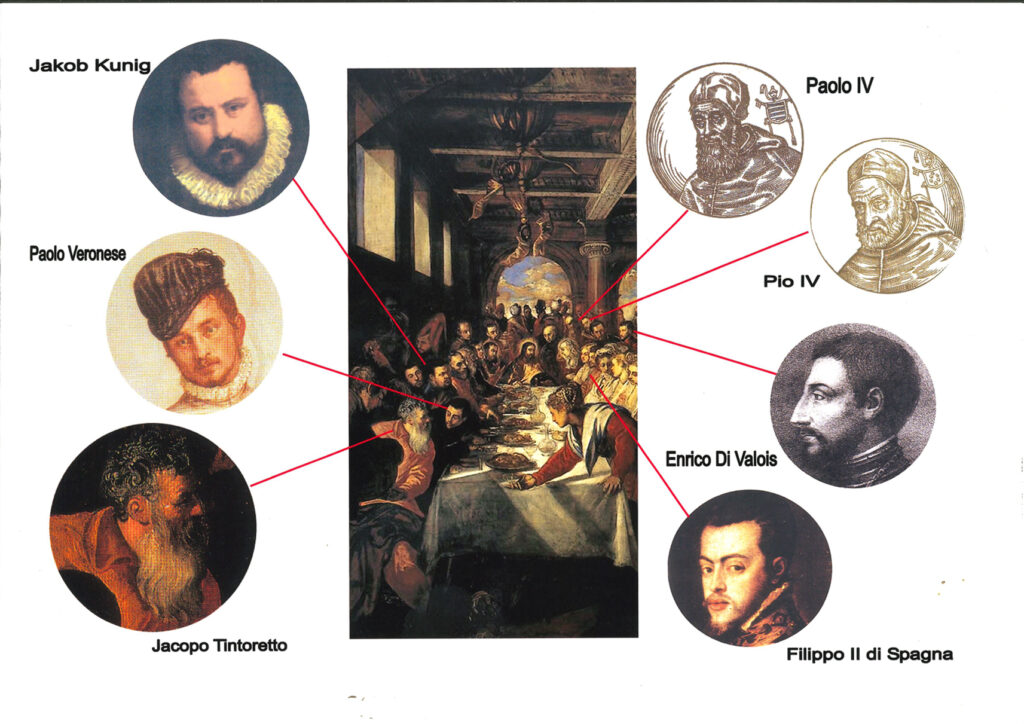SEARCH EVENT
Sezione "Tintoretto"
Sezione "Tintoretto"
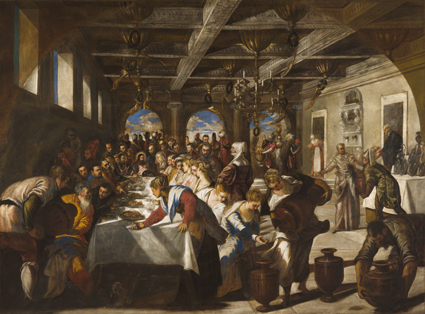
Nel 1513 un incendio distrusse l’intero complesso dei frati Crociferi. Ne fu decisa subito la ricostruzione, conclusasi nel 1555 circa. Nel nuovo monastero fu posta l’attenzione all’apparato pittorico con l’intenzione di coinvolgere il Veronese.
Il Ridolfi (1648) narra come il Tintoretto propose con insistenza il proprio stile ricevendone il consenso solo garantendo di imitare il Veronese. Eseguita per l’altar maggiore l’Assunzione della Vergine (ora si trova nella Chiesa dei Gesuiti) con successo, gli venne commissionato per il refettorio del monastero la tela “Nozze di Cana”, capolavoro eseguito e firmato nel 1561, ora nella sacrestia della Salute. L’opera da sempre considerata del periodo “ veronesiano” ebbe un notevole successo , tanto che in più parti si conservano copie del dipinto. E’ importante tener presente il contesto originale in cui si trovava: il Tintoretto infatti, forse su richiesta della committenza, ebbe l’idea di dare con il dipinto maggior profondità e continuità alla sala continuando nel dipinto stesso la prospettiva, le travature del soffitto e le finestre della sala stessa, e per conseguenza la tela indica la disposizione originale della luminosità discendente da destra a sinistra. Per ottenere un effetto ancor più coinvolgente, dipinse la tavola, resa luminosa dalla tovaglia bianca, in modo tale che pur apparendo otticamente lunga e stretta, in realtà è più larga che lunga, ottenendo un effetto ottico di “seguire” lo spettatore in modo frontale ovunque si metta. Tintoretto poi, volendo completare il gruppo di persone di sinistra in primo piano volle ritrarre se stesso nel personaggio con barba bianca vestito di arancio, a cui viene mostrata la coppa vuota di vetro dalla modella centrale ed inserendo la firma accanto al proprio manto.
Le conseguenze della guerra di Candia (Creta) 1644-1669 che si protrasse per 24 anni, condussero l’erario della Repubblica Veneta al fallimento , obbligando i veneziani a cercare finanziamenti ovunque. Alcuni ordini religiosi furono sciolti e i beni devoluti alla difesa dell’Isola di Candia ridotta all’assedio. I Crociferi nel 1656, per ordine di Alessandro VII vennero gradualmente ridotti di numero fino allo scioglimento completo, e anche i loro beni confiscati e venduti ai Gesuiti a cui venne dato il consenso di rientrare a Venezia, dopo le note vicende dell’Interdetto. In questo passaggio di proprietà il priorato dei Crociferi , ormai non più esistente come ordine religioso, cercò di vendere la tela delle “Nozze di Cana” al Gran Duca Leopoldo de’ Medici, tramite il suo agente Poalo Del Sera. I Procuratori si San Marco presero in mano la cosa e proposero loro l’asta del dipinto chiedendo un prezzo altissimo, ma non riuscendo nella vendita. Nel 1657 risultò in deposito a San Giorgio Maggiore sino all’ultimazione dei lavori della Basilica della Salute, e poi collocato direttamente in sacrestia.
La tela (su indicazione di Odoardo Fialetti, seguace del Tintoretto) risultava, in origine, adornata di due stemmi negli angoli alti, inerenti all’ordine dei Crociferi stessi, che furono tolti all’inizio del ‘700. In modo anonimo il dipinto fu completato ricoprendolo di vernice ossidatasi nel tempo. L’ultimo restauro (1986) ne curò la pulitura limitandosi alla forma originale, e fu scoperto che in realtà vi è mimetizzata la raffigurazione di un celebre matrimonio dell’epoca, con vari ritratti di personaggi, di cui alcuni riconosciuti.
_______________________________
In 1513, a fire destroyed the entire complex of the Cruciferous friars. It was immediately decided to rebuild it, which was completed around 1555. In the new monastery, attention was paid to the pictorial apparatus with the intention of involving Veronese.
Ridolfi (1648) recounts how Tintoretto insistently proposed his own style, only receiving approval by guaranteeing to imitate Veronese. Having successfully executed the Assumption of the Virgin for the high altar (now in the Jesuit Church), he was commissioned for the monastery refectory the painting ‘Wedding at Cana’, a masterpiece executed and signed in 1561, now in the sacristy of the Salute. The work, always considered to be from the ‘Veronese’ period, was so successful that copies of the painting are preserved in several places. It is important to bear in mind the original context in which it was located: Tintoretto in fact, perhaps at the request of his patrons, had the idea of giving the painting greater depth and continuity to the room by continuing the perspective, ceiling beams and windows of the room itself in the painting, and consequently the canvas shows the original arrangement of the light descending from right to left. To achieve an even more engaging effect, he painted the table, made luminous by the white tablecloth, in such a way
such that while optically appearing long and narrow, in reality it is wider than long, achieving an optical effect of ‘following’ the viewer frontally wherever he stands. Tintoretto then, wishing to complete the group of people on the left in the foreground, wanted to portray himself in the white-bearded figure dressed in orange, who is shown the empty glass cup by the central model and inscribing his signature next to his own cloak.
The aftermath of the war of Candia (Crete) 1644-1669, which lasted for 24 years, led the treasury of the Venetian Republic to bankruptcy, forcing the Venetians to seek funding everywhere. Some religious orders were dissolved and assets devolved to the defence of the besieged island of Candia. The Cruciferous in 1656, by order of Alexander VII were gradually reduced in number until they were completely dissolved, and their property confiscated and sold to the Jesuits who were allowed to return to Venice, after the well-known events of the Interdict. In this change of ownership, the Priory of the Crucifers, no longer existing as a religious order, tried to sell the painting of the ‘Wedding at Cana’ to Grand Duke Leopold de’ Medici, through his agent Poalo Del Sera. The Procurators of St. Mark’s took matters into their own hands and offered the painting for auction at a very high price, but failed in the sale. In 1657, it was in storage at San Giorgio Maggiore until the completion of work on the Basilica della Salute, and then placed directly in the sacristy.
The canvas (on the instructions of Odoardo Fialetti, a follower of Tintoretto) was originally adorned with two coats of arms in the upper corners, relating to the order of the Crucifers themselves, which were removed in the early 18th century. The painting was anonymously completed by covering it with varnish that had oxidised over time. The most recent restoration (1986) cleaned it, limiting it to its original form, and it was discovered that it actually contains a depiction of a famous wedding of the time, with various portraits of people, some of whom are recognised.
